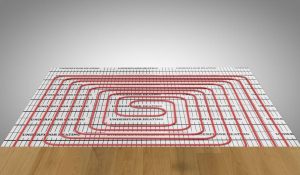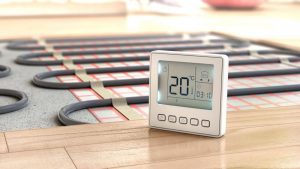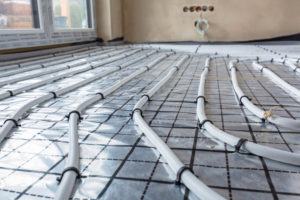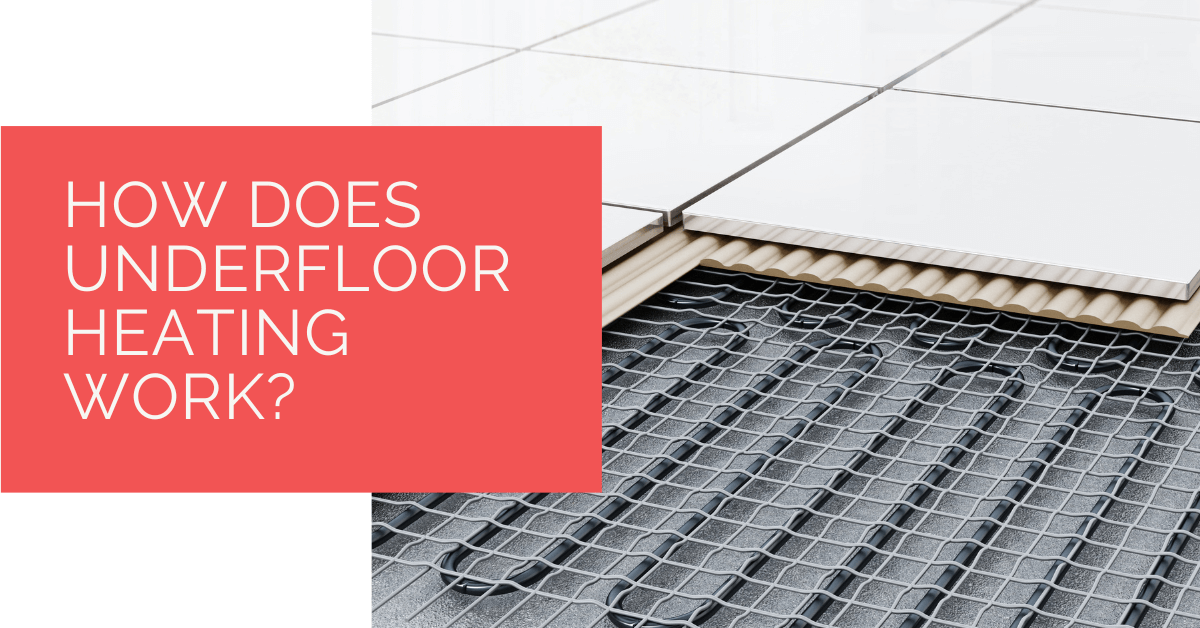Underfloor heating (UFH) is fascinating if you think about it. How does this system employ radiant heat to maintain even warmth distribution in a room or house?
If you’re asking: “How does underfloor heating work?” perhaps you’re thinking of installing underfloor heating, or you’re simply curious.
We’ll help you understand how electric and water underfloor heating systems operate.
Contents
Key Takeaways
- Water underfloor heating systems involve the installation of hydronic heating pipes under the floor, with warm water running through them, turning the floor into a radiant heat source. Heat sources, such as boilers and heat pumps, can supply warm water, and thermostats regulate the temperature.
- Electric underfloor heating systems use cables, mats, or wires installed under the floor connected to an electric supply. A thermostat controls the temperature, and proper insulation is essential for efficient operation.
- Water systems suit new constructions and larger areas, while electric systems are more adaptable to existing houses and smaller spaces. Water systems tend to have lower ongoing operating costs, while electric systems are cheaper to install but may have higher operating costs depending on factors like room size and insulation.
How Does Water Underfloor Heating Work?
Professionals or handy DIYers install hydronic heating pipes under the floor surface. Warm water runs through these pipes to radiate heat in the room. This way, the floor acts as a big radiator, distributing heat evenly and gently.
Underfloor heating systems may get this water from a boiler, solar water-heating system, or renewable ground or heat source pumps.
Boilers are usually the most traditional heating source for water systems. This is because they pump low-temperature hot water. This is especially true for modern high-efficiency condensing boilers because they get to work in condensing mode.
Heat pumps are also rising in popularity, thanks to their energy-saving features. Regardless of your chosen heat source, it must be connected to the pipes, where a manifold comes in.
But what is a manifold? It’s the central distribution point composed of two rows of tabs that allow the warm water to move from the heating source to the underfloor circuits.
Additionally, you have one or more thermostats, depending on how big the area that needs heating is. They regulate the temperature to ensure it’s comfortable (only a few degrees higher than the air temperature). Note that a part P-certified/NICEIC electrician should be in charge of the thermostat installation.
With quality insulation (like insulation boards), you’ll decrease heat-up time and minimise heat loss to the subfloor, as the heat will be directed to floor level.

How Does Electric Underfloor Heating Work?
It all starts with underfloor heating cables, mats, or very thin wires, which also come available as underfloor heating kits. If you choose mats, you’ll see a series of wires connected to a mat at regular intervals. The mat can even be cut and fitted to size. These systems are easy to install but tricky if you’re working in a small or oddly shaped room.
As for loose wires, you have more freedom with how you lay them, which is excellent for irregularly shaped rooms. Note that the wires must be placed at even distances for uniform heat transference.
Professionals or competent DIY people can install them on a layer of floor insulation to prevent heat from travelling downwards. You need a flat surface, so that’d be a layer of screed (sand and cement) or floorboards on joists.
Afterwards, a part P-certified/NICEIC electrician connects the heating wire to your electric supply, which may generate 100w to 200w per square metre. However, the wattage depends on the room size, room shape, insulation installed, flooring underneath, and flooring on top.
Also, you’ll have a sensor regulating and monitoring the temperature. You can use a thermostat to control it (installed by a certified electrician), and you can set it so that it automatically shuts down or operates at a certain temperature. Like water underfloor heating, you’ll want sufficient insulation.

About Thermostats
Thermostats are a basic component of both water and electric underfloor heating systems, but they aren’t all the same. Here’s how the three main thermostat types contribute to a heating system.
- Smart Thermostat: This expensive device allows you to control your heating from afar using an app or so. Also, it offers you diverse control options.
- Programmable Thermostat: You can program the system to turn on and off automatically when you want. And you can pre-set the temperature you want.
- Traditional Thermostat: The least expensive option comes with a dial for manual control.
Water vs Electric Underfloor Heating
There are several ways in which these systems differ. Knowing their differences will help you better understand how they work.
Project Type
Are you building a property? If so, you can opt for a water system as it accommodates its labour-intensive installation process. After all, workers can plan for these pipes in the property design stage.
Otherwise, electric underfloor heating suits existing houses because you don’t have to uproot your entire flooring and it can easily fit the electric system. Also, you’ll barely notice any changes in the floor height.
Temperature
What temperature should you expect each underfloor heating system type to run at? According to the British Electrotechnical and Allied Manufacturers Association (BEAMA), for underfloor heating, the water temperature should be 35°C, which is lower than radiators, typically 55°C to 65°C.
Still, it depends on the type of flooring, its thickness, and how well it permits heat. If it’s difficult for heat to travel through your flooring, you’ll need to set it at a higher temperature.
An electric underfloor heating runs at a lower temperature (25°C to 31°C on average). Likewise, the flooring type, including what’s on top and what’s underneath, affects the temperature.

Rooms
Are certain rooms more suited towards one of the underfloor heating systems than others? Yes, although you can install water or electric underfloor heating anywhere, that might not be a good idea.
Instead, many people select a water system for their kitchens and living rooms. The system requires space for the heating pipes, and it raises your finished floor level, so we recommend installing it in large areas.
As for electric underfloor heating, you can install it in bathrooms and other small spaces (like small kitchens). After all, they aren’t as bulky as water systems. They’re, however, more expensive in the long run, which renders them suitable for limited spaces.
Cost
When you invest in a water underfloor heating system, you pay less on ongoing costs. After all, electricity is much more expensive than gas, which typically powers water underfloor heating systems. Not to mention, it needs 25% less energy than radiators, decreasing its costs.
Otherwise, electric underfloor heating systems are expensive to operate, but they’re cheaper to install. Their running costs vary depending on your room size, how new the underfloor heating system is, the home insulation, and your energy tariff.
On average, you can expect that underfloor heating would cost £4 to £6 a month if you turn it on four hours a day in a 2.5m bathroom.
Heat Pump Source: Reliable Heating and Cooling Solutions
At Heat Pump Source, we take pride in our unwavering commitment to serving the UK with top-tier HVAC solutions. From the efficiency of heat pumps and the cool relief of air conditioning to the warmth of boilers, radiators, and underfloor heating, our dedicated team is always at the forefront of innovation. We understand the unique needs of every household and business, and we strive to provide dependable health and cooling products and services that are tailored just for you. Ensuring your comfort and satisfaction is our utmost priority. Whether you have questions, need guidance, or require support, we’re always here to assist. Please don’t hesitate to contact us; we’re eager to be of service.
Final Words
To understand how underfloor heating works, you have to distinguish between water and electric systems. The former type contains pipes that pump warm water from a boiler or other heat source and radiate heat to the floor, whereas the latter depends on cable, mats, or very thin wires connected to an electric supply.
Both evenly distribute heat all over the room or space flooring and need thermostats to control their temperatures. This way, you can enjoy a comfortable and even temperature around your house.
About the Author
At Heat Pump Source, our articles are the product of a collaborative effort among a team of highly skilled HVAC experts. Our dedicated professionals, hailing from diverse backgrounds in heating, ventilation, air conditioning, and refrigeration, contribute their extensive knowledge and experience to every piece of content. This multidisciplinary approach ensures comprehensive coverage. Our commitment is to deliver authoritative, reliable, and tailored advice to meet the unique needs of every household and business across the UK.

